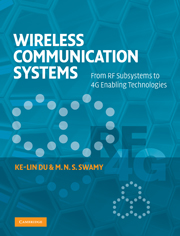Book contents
- Frontmatter
- Contents
- Preface
- Abbreviations
- 1 Introduction
- 2 An overview of wireless communications
- 3 Channel and propagation
- 4 Cellular and multiple-user systems
- 5 Diversity
- 6 Channel estimation and equalization
- 7 Modulation and detection
- 8 Spread spectrum communications
- 9 Orthogonal frequency division multiplexing
- 10 Antennas
- 11 RF and microwave subsystems
- 12 A/D and D/A conversions
- 13 Signals and signal processing
- 14 Fundamentals of information theory
- 15 Channel coding
- 16 Source coding I: speech and audio coding
- 17 Source coding II: image and video coding
- 18 Multiple antennas: smart antenna systems
- 19 Multiple antennas: MIMO systems
- 20 Ultra wideband communications
- 21 Cognitive radios
- 22 Wireless ad hoc and sensor networks
- Appendix A The Q-function
- Appendix B Wirtinger calculus
- Index
5 - Diversity
Published online by Cambridge University Press: 05 June 2012
- Frontmatter
- Contents
- Preface
- Abbreviations
- 1 Introduction
- 2 An overview of wireless communications
- 3 Channel and propagation
- 4 Cellular and multiple-user systems
- 5 Diversity
- 6 Channel estimation and equalization
- 7 Modulation and detection
- 8 Spread spectrum communications
- 9 Orthogonal frequency division multiplexing
- 10 Antennas
- 11 RF and microwave subsystems
- 12 A/D and D/A conversions
- 13 Signals and signal processing
- 14 Fundamentals of information theory
- 15 Channel coding
- 16 Source coding I: speech and audio coding
- 17 Source coding II: image and video coding
- 18 Multiple antennas: smart antenna systems
- 19 Multiple antennas: MIMO systems
- 20 Ultra wideband communications
- 21 Cognitive radios
- 22 Wireless ad hoc and sensor networks
- Appendix A The Q-function
- Appendix B Wirtinger calculus
- Index
Summary
Diversity methods
Two channels with different frequencies, polarizations, or physical locations experience fading independently of each other. By combining two or more such channels, fading can be reduced. This is called diversity. Diversity ensures that the same information reaches the receiver from statistically independent channels. There are two types of diversity: microdiversity that mitigates the effect of multipath fading, and macrodiversity that mitigates the effect of shadowing.
For a fading channel, if we use two well-separated antennas, the probability of both the antennas being in a fading dip is low. Diversity is most efficient when multiple diversity channels carry independently fading copies of the same signal. This leads to a joint pdf being the product of the marginal pdfs for the channels. Correlation between the fading of the channels reduces the effectiveness of diversity, and correlation is characterized by the correlation coefficient, as discussed in Section 3.4.2. Note that for an AWGN channel, diversity does not improve performance.
Common diversity methods for dealing with small-scale fading are spatial diversity (multiple antennas with space separation), temporal diversity (time division), frequency diversity (frequency division), angular diversity (multiple antennas using different antenna patterns), and polarization diversity (multiple antennas with different polarizations). Macrodiveristy is usually implemented by combining signals received by multiple BSs, repeaters or access points, and the coordination between them is part of the networking protocols.
- Type
- Chapter
- Information
- Wireless Communication SystemsFrom RF Subsystems to 4G Enabling Technologies, pp. 130 - 157Publisher: Cambridge University PressPrint publication year: 2010



